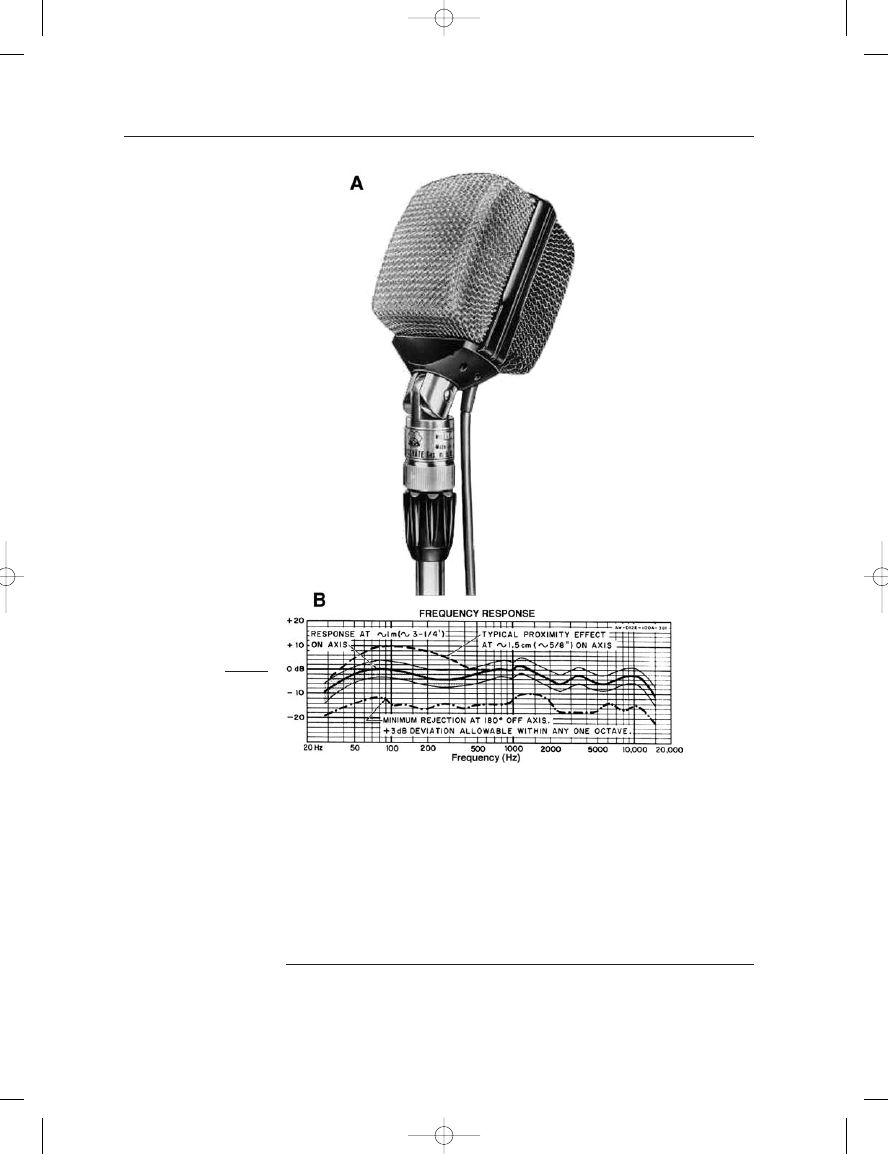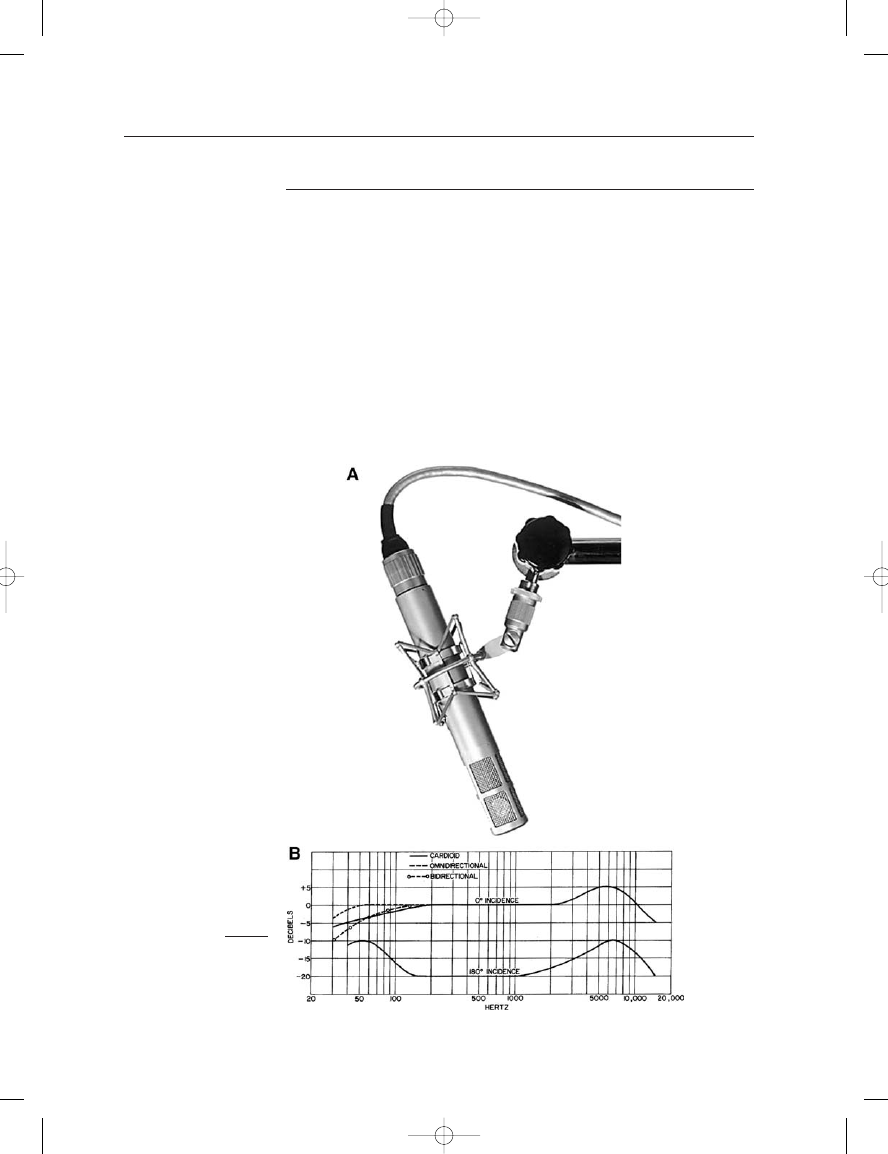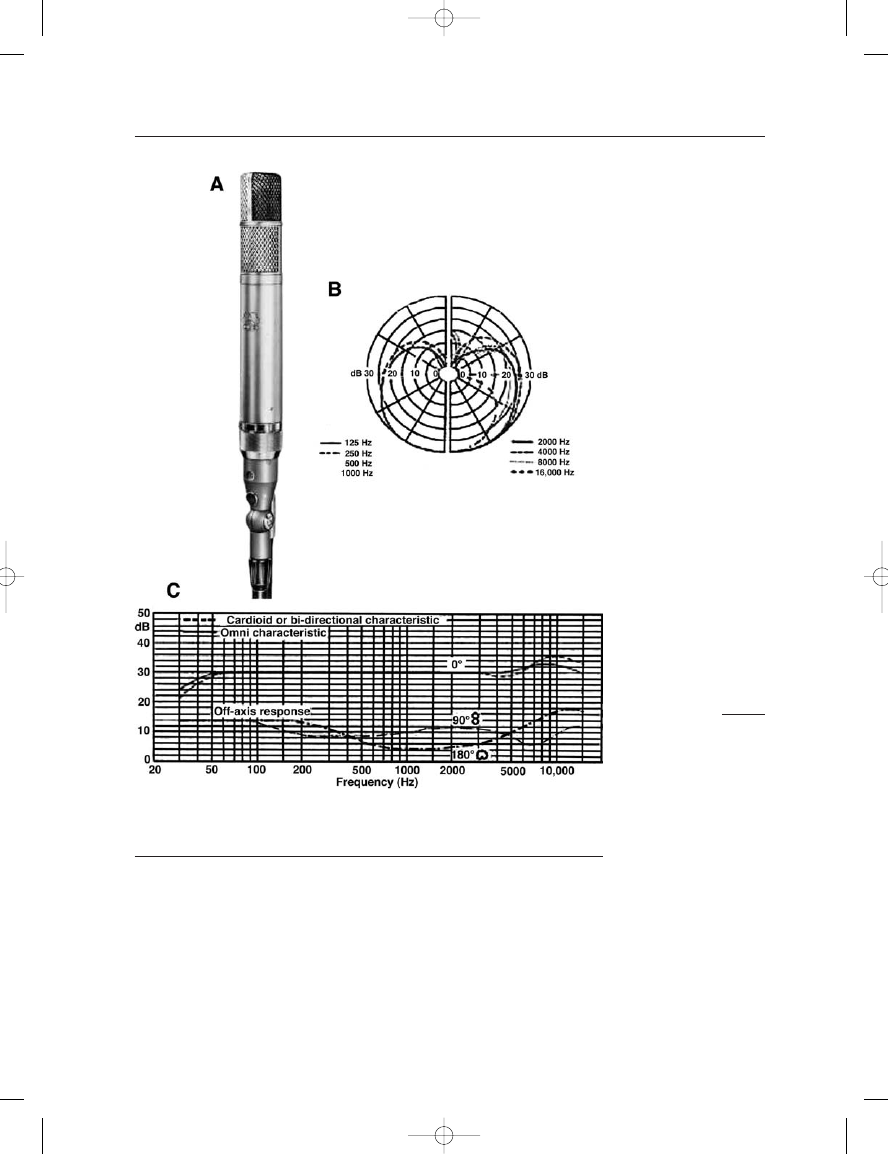ВУЗ: Казахская Национальная Академия Искусств им. Т. Жургенова
Категория: Книга
Дисциплина: Не указана
Добавлен: 03.02.2019
Просмотров: 17241
Скачиваний: 51

21: Classic Microphones: The Author’s View
353
in studio work for its abilities to handle high levels and became a favorite,
both in Europe and the US, for kick drum pickup. The design of the micro-
phone included a very linear moving system and a LF resonance chamber
which extended the response down to about 30 Hz. Figure 21–16A shows
a photo of the model, and frequency response curves are shown at B. You
will find many D-12s still in use, and the model is one of very few single
diaphragm dynamic cardioids to have attained such vintage status.
SONY MODEL C-37A CAPACITOR MICROPHONE
The C-37A quickly became a lower cost alternative to the Telefunken
U47 when it was introduced during the mid 1950s, and it is easy to
FIGURE 21–16
AKG Acoustics Model
D-12: photo of microphone
(A); various response
curves (B). (Data courtesy
of AKG Acoustics.)
Earg_21.qxd 14/9/04 3:08 PM Page 353

see why. As is clear from Figure 21–17B, the response was remarkably
flat to 20 kHz, lacking the rise in the 10 kHz range which characterized
many of the European dual diaphragm capacitors. Notable also is the
integrity of the cardioid pattern, which retains its
90 target response
of
6 dB remarkably well to just below 10 kHz. By any measure this is
excellent response from a nominal 25 mm (1 in) diameter diaphragm.
The only negative design comment that can be made is the susceptibility
of the perforated metal screen to show dents – much the same way the
RCA ribbons do.
THE MICROPHONE BOOK
354
FIGURE 21–17
Sony Model C-37A dual
pattern capacitor. (Photo
courtesy of Eric Weber;
data at B from Sony
specification sheet.)
Earg_21.qxd 14/9/04 3:08 PM Page 354

21: Classic Microphones: The Author’s View
355
THE FIRST STEREO MICROPHONES
The promise of stereo in the mid 1950s gave rise to a number of capacitor
microphone models in which rotatable, variable pattern elements were
stacked vertically. Notable models here were made by Neumann, AKG
Acoustics, and Schoeps, and they were all quite similar in overall design.
Only the capsule at the end of the stem was rotatable, but both capsules
had variable patterns. All were tube types, but the designs changed
rapidly with the coming of solid state electronics and phantom powering
during the 1960s. The Neumann and AKG models used dual diaphragm
capsules while the Schoeps model used their hallmark single diaphragm
capsule with acousto-mechanical pattern changing.
FIGURE 21–18
Neumann Model SM2
stereo microphone.
(Data courtesy of
Neumann/USA.)
Earg_21.qxd 14/9/04 3:08 PM Page 355

NOTABLE AMERICAN CAPACITOR OMNIS
As the 1950s got under way it seemed that high-end microphone tech-
nology was rapidly becoming a European specialty. In all other respects,
including basic recording technology, loudspeakers, and the electronic
chain, American companies were very much in the running – and in fact
had led in the early development of the post-war art. But in the micro-
phone area, American companies had invested heavily in dynamic and
ribbon technology while the recording industry had firmly endorsed the
newer capacitor microphones as the leading edge in design.
THE MICROPHONE BOOK
356
FIGURE 21–19
AKG Acoustics Model
C-24 stereo microphone.
(Data courtesy of AKG
Acoustics.)
Earg_21.qxd 14/9/04 3:08 PM Page 356

21: Classic Microphones: The Author’s View
357
A handful of American companies, some of them quite small, responded
to this challenge. Noting that omni capacitors were relatively straight-
forward in concept, they decided to make their individual contributions
in this direction. Those companies were: Altec, the most prominent
manufacturer of systems for motion pictures and sound reinforcement;
Stephens Tru-Sonic, a manufacturer of high-end loudspeakers; Capps and
Company, a manufacturer of disc recording styli; and a small California
company, Stanford-Omega.
The Altec M21 system is shown in Figure 21–21A. The basic design
was begun in the late 1940s, and a number of capsule designs were exper-
imented with. The version shown here was unique in that sound reached
the diaphragm indirectly through a circular opening around the rim, which
can be seen in the cutaway view at B. The diaphragm itself was a piece of
optical quality glass ground to a thickness of approximately 0.013–0.02 in,
FIGURE 21–20
Schoeps Model CMTS-501
stereo microphone. (Data
courtesy of Schoeps GmbH.)
Earg_21.qxd 14/9/04 3:08 PM Page 357